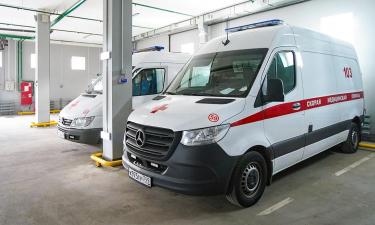Great Construction Project of Russian Capitalism
 The Bureya River, which cuts through virgin woods, hills and mounds, runs towards the Russian-Chinese border and before reaching the border it joins the Amur, the largest river in the Far East. A hydroelectric power station under construction there has been named after the Bureya.
The Bureya River, which cuts through virgin woods, hills and mounds, runs towards the Russian-Chinese border and before reaching the border it joins the Amur, the largest river in the Far East. A hydroelectric power station under construction there has been named after the Bureya.
Anatoly Chubais, chief of Unified Energy Systems, Russia's electricity monopoly, has called the power station a "great construction project of capitalism." On the day the act to commission the Bureya Power Station's first generating unit was signed, Chubais announced a 10% stage-by-stage reduction of electricity charges in the region.
The Bureya Power Station is the first large electricity project in post-Soviet Russia. Its importance - political, social, economic and even moral - is so great that President Vladimir Putin attended the commissioning ceremony of its first generating unit on July 9 this year. He was given the privilege of pushing the button to put the first generating unit on stream.
The power plant is to supply electricity to the energy-hungry Far East, increase the reliability of power supply there and reduce the levels of organic fuel delivered to the region. Experts forecast that in 2004 the station's generating capacities will allow over 1.5 million tonnes of coal to be saved. When Bureya is running at full capacity, this amount will increase to five million tonnes a year. The project is also designed to prevent seasonal floods in the Bureya flood-lands and in the middle reaches of the Amur. Moreover, there is a foreign-economic aspect: to create the possibility of electricity exports, in particular to China. By this June, $1.3 billion had been spent on the construction of the first generating unit.
Experts focused on the Bureya and also on the Zeya, another tributary of the Amur, before World War II, as there was electricity shortage in the area. The region was abundant in natural resources, but they needed to be developed. Accordingly, the Zeya power station was built between 1964 and 1980. The location for the Bureya power project was selected in 1973 - the Talakan Site was ideal for a dam - and construction began in spring 1976.
The first problems were of a humanitarian nature. There were several old villages with meagre populations in the area of the future water reservoir. Local people were provided with housing in a new well-developed settlement, while a cemetery was also moved to the new place.
The Bureya power station was designed by experts in Leningrad (modern-day St Petersburg). As the dam was to be built in an earthquake zone, an expensive concrete monolithic model was chosen. Over 3 million cubic metres of concrete grout is to be poured into the dam's body, but so far, only one-third of this task has been completed. When finished, the dam will be 139 metres high, 765 metres long and 100 metres wide at the bottom and 25 metres wide at the top. The reservoir (which has been called the Bureya Sea) measures 256 kilometres in diameter and it will hold 20.94 cubic kilometres of water. The station's total capacity will be 2,000 megawatts, and its annual electricity output will be 7.1 billion kilowatts per hour. This will help to put an end to electricity shortages in the Far East and free the area from its dependence on coal deliveries from other regions.
In the final years of the Soviet era, the budget could not afford to finance major projects. After the break-up of the USSR, economic shock therapy in Russia nearly spelled the end of the project. Work at the construction site dragged on, and the workers, who were not paid for months, went on strike more often than not.
In 2000, Unified Energy Systems took over the "interminable" construction project and became its main investor. The Railways Ministry and the federal government, too, provided some financing. Only then did construction work move into a high gear.
The Bureya Power Station is an ambitious and technically unique project. Immense permanently sealed water turbines, each weighing 100 tonnes, are delivered by a huge Ruslan aircraft to a military airfield located 80 km away from the power station and designed for receiving the Russian Buran space shuttle. The first two turbines were brought there on 400-tonne platforms. Engineers believe that such monolithic turbines, through difficult to transport, are easier and cheaper to run.
Five thousand people, mostly high-class specialists from all over the country, are involved in the power station's construction. Vadim Vasilevsky, deputy chief engineer of the BureyaGESstroi company, says, "this project has virtually saved the Russian hydro-technical engineering school, as in four or five years all the experts would have dissolved in other industries."
The most up-do-date world technologies are being employed in the construction. The highly computerised equipment in use has practically changed the traditional commissioning concept, says Valery Vasilyev, chief construction electrician. "At this power station the switchgear is on a hilltop, right over the dam. From there electricity will be supplied in the main directions. The station's entire electrical scheme is on the control panel, and one can switch on or off any unit, mechanism or individual tumbler at the touch of a button," he says. A special control program has been designed by Russian engineers together with the IBB company, while optical-fibre lines ensure high-speed parameter processing to control the protection of the generator units and the station's main control panel. The first three units will be put into operation with temporary water lines and at reduced pressure. This technological solution allows the hydro-system's payback time to be considerably reduced. The construction of the Bureya hydroelectric power plant will be completed in 2009, when six turbines with an aggregate power of 2 million kilowatts are installed, but today it is too early to speak about the project's final price.
The programme to commission the second unit, which is being implemented at present, practically repeats the process of starting the first one, as both units are highly similar (each is capable of generating 185 megawatts at reduced pressure). The first connection to the network is slated for November 1. Then after two weeks of adjustment, the second unit will be ready for industrial service.
It would seem that the arguments proving the power station's importance for the Far Eastern region are indisputable. But still there is reason to speak about the construction's possible negative environmental impact.
This electricity system consists of two independent facilities: the generators producing electricity (the property of the UES) and the water reservoir, which is federal property. Each of the facilities affects the environment. The impact of the power station, associated with accumulation and discharge of water, affects mainly the lower bay.
According to some environmentalists, the flooding of the reservoir may seriously harm the environment, as the Amur will receive less water. This will affect the system of flood-lands, fish reproduction and navigation. The lowering of the water level in the Bureya will affect the state of the lakes and marshes near the Khingan Preserve. Botanists believe that the unique Far Eastern lotus growing in Lake Dolgoye will become extinct after the water level goes down.
Power engineering specialists are trying to respond to the environmentalists' concern. The UES management has launched a social and environmental monitoring programme for the period until 2017. It includes observations in seismic activity, meteorology, hydrology, ichthyology, zoology, and others. The programme will cost UES 34 million rubles ($1 equals approximately 30 rubles). Eighteen research institutes and environmental organisations are taking part in the monitoring. The programme will allow a comprehensive assessment of social and environmental changes accompanying the construction of the power station to be made, as well as the appropriate corrections in nature management to be introduced in due time.
Tatyana Sinitsyna, RIAN
Subscribe to Pravda.Ru Telegram channel, Facebook, RSS!





